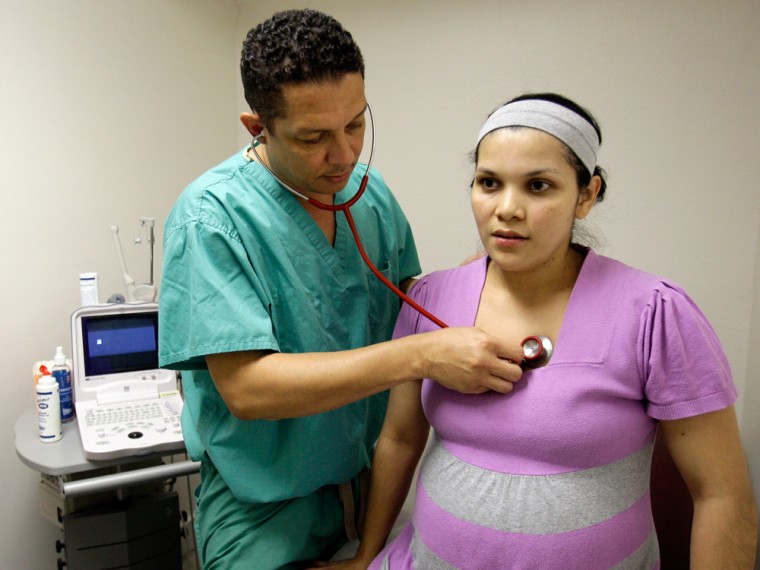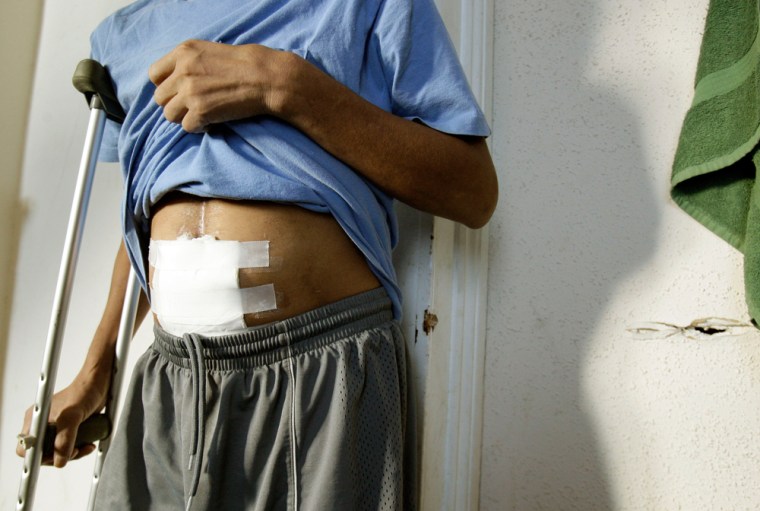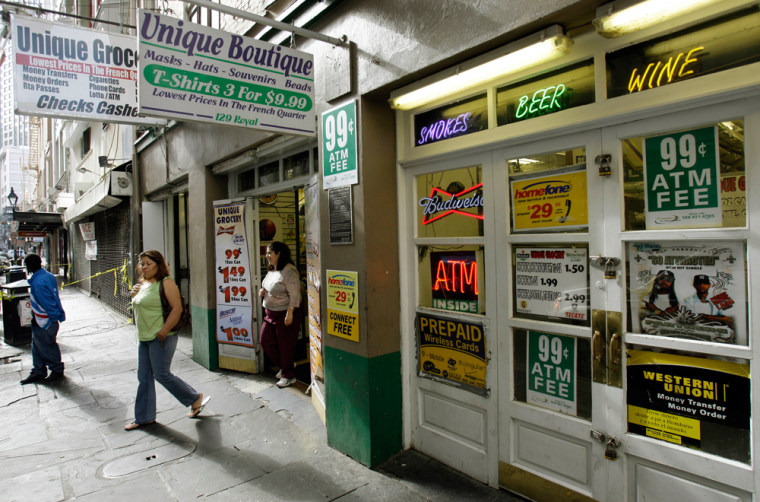On Friday nights, day laborers form two lines at a bustling liquor store in the French Quarter: one is to dutifully wire money to their homelands, the other is to buy $2.17 beers that medicate their lives in New Orleans.
"Life is hard here, harder than any place I've been in the U.S.," said Jose Campos, 37, who came here from El Salvador, by way of Florida. He rode is bike to Unique Grocery, a cavernous establishment off Bourbon Street that offers the wire service through bulletproof glass and tall-boy beers from icy bins.
"It's a dangerous place, a bad place," he said. "But when you can find work, it's all worth it."
Workers drawn to construction jobs
In the three years since Hurricane Katrina, immigrant laborers drawn to the construction and service industry jobs created by the storm have transformed this rebuilding city. In an accelerated version of the already rapid Latino migration to the South, they are forging their own support networks, establishing businesses, packing churches and starting families — a process that usually takes a decade or more.
"There's no place in the world like New Orleans in terms of how rapid the population change has been," said Margie McHugh, co-director of immigration integration policy at the Migration Policy Institute, a nonpartisan think-tank in Washington D.C.
But in a city whose infrastructure already lacked public services to support its pre-Katrina population, let alone a Spanish-speaking pilgrimage, they have also become preferred victims of the city's infamous crime rate. And, far from wives and children, many have wrestled with the Big Easy temptations of alcohol and drugs.
"It's always difficult to be a trailblazer, particularly at a time when New Orleans is still struggling to rebuild from an awful blow," said McHugh.

A 2006 study by Tulane University and the University of California, Berkeley, found that nearly half the rebuilding work force was Latino. Fifty-four percent were working illegally in the United States, and nearly 90 percent of illegal workers lived in the U.S. before coming to town.
Beyond the statistics, there are the offices of Dr. Kevin Work, who has forged a business by delivering a generation of Latino children to the city: "Thirty to forty deliveries a month," he says.
Work was seeing so many Spanish-speaking patients at the hospital where he worked that he decided to open two prenatal offices with his own money. The doctor, who has hired bilingual staff and learned a few halting Spanish phrases himself, estimates he has delivered more than 1,000 children from immigrant mothers since Katrina struck in August 2005.
He offers payment plans, and those who cannot pay are covered by government programs.
Program now includes prenatal care
The year before Katrina, Emergency Medicaid expenses were $1.7 million in metro New Orleans. It was the common childbirth benefit used by recent immigrants, but provided no prenatal care. This year the program expanded to include prenatal care and five times as many patients, ballooning costs to $7.8 million.
"By incorporating illegal immigrants into our normal institutions this way, we legitimize their status," said Mark Krikorian, executive director of the Center for Immigration Studies, a Washington D.C. think-tank that advocates for stricter immigration policy.
Dawn Love, spokeswoman for the Louisiana Children's Health Insurance Program, said prenatal programs ultimately save taxpayers because healthier infants need fewer services later in life.
Claudia Cruz, 30, came to post-Katrina New Orleans from Honduras, joining her U.S.-born husband, Miguel Vasquez, 41. Cruz leaned back on an examination bed recently, while Work waved a sonogram wand over the slope of her stomach.
"He's eighty-five percent sure it's a girl," she revealed to Vasquez in the waiting room. "If it's another girl, the name's going to be Andrea," he answered, holding his first New Orleans-born daughter, 13-month-old Daneila.
Some feel imprisoned by city
But for every hopeful family, there are others who feel imprisoned by the city.
One is a gaunt, 32-year-old man from Oaxaca, Mexico who spends his days on a dingy mattress, recovering from a bullet wound.
The man, who asked that his name be withheld because he is in the country illegally, was walking from a nearby discount store at the end of a work week. It was an opening for armed robbers who target immigrants because they are known to be paid in cash and are reluctant to report crimes.
After the man fled with his pay, the robbers chased him down his block, into his apartment, and fired three rounds. Two found the living room wall, one, a narrow torso now covered by bandages and scars.
"They were just boys, maybe eighteen," said the victim, who was treated at a local emergency room, where he had no choice but to report the crime.
New Orleans named most violent city
The New Orleans Police Department is investigating the case, one of a spree of armed robberies against immigrants.

A November study found New Orleans to be the most violent city in America, and the department will be adding a need for more Spanish-speaking officers to a list of needs.
"If we find ways to educate workers, say 'Hey, look, don't carry so much money,'" the crimes against immigrants can be reduced, said Janssen Valencia, a Spanish-speaking officer assigned in September to start an NOPD immigrant outreach.
Valencia has been making the rounds on Spanish radio shows, urging immigrants to report crimes without deportation consequences. He acknowledges that even if immigrants step forward, the department has fewer than a dozen patrol officers who can take an accurate report in Spanish.
"That's just not good enough," said Valencia.
One answer to the language barrier has been an investment in a school that immerses immigrant children in English instruction.
No questions asked
At Esperanza Charter School, no questions are asked about the immigration status of families. The school teaches from kindergarten to 8th grade. The director is lobbying for the district to start a high school and extend the specialized academic path all the way to college.
"This school would not have even been possible before Katrina," Director Melinda Martinez said.
With 60 percent of its students Latino, 30 percent African American and 10 percent white, the school has a waiting list about 15-students deep in each grade. Some never enroll because of the transient lives of their parents.
"Sometimes, a child is never seen or heard from again," said Martinez, who believes the parents were either deported, or packed up for a less-difficult places.
For those who remain in New Orleans, straddling a troubled city and a troubled homeland has led to disillusionment, sometimes dependency.
The director of the Council on Alcohol and Drug Abuse for greater New Orleans said the nonprofit had about a half dozen Spanish-speaking clients before Katrina. In the last year, the number increased to 50.
Outreach on dangers of drugs
In response, the organization has established yet another Hispanic outreach in New Orleans, this one to educate youth on the dangers of drugs.
"We have young people who have not seen their parents in five years," said Italia Castillo Duran, who directs the effort. "We have parents who have one child here, and another back in their homeland."
At one time, Arturo, 33, dreamed of providing an American future to his daughter, Beberly Esther, 7. But three years after he arrived illegally from Guatemala, construction work has dried up and he has little money to send home.
Arturo, who requested his last name be withheld for fear of deportation, said he has managed to resist the temptations that have consumed others.
"A lot of people start getting addicted. Maybe they have a wife, wondering, waiting," he said. "You can lose your family at home. While you lose yourself in New Orleans."
